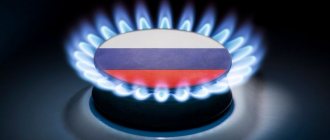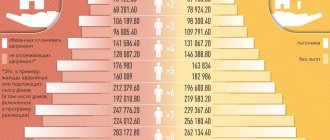Utility tariffs
A tariff is the price for a service, which can be set either per unit of resource provided (for example, per cubic meter of water) or per unit of time for those services that are provided to everyone equally (for example, elevator maintenance).
Federal legislation establishes that tariffs can be changed and new ones introduced no more often than once a year. Regional standards for tariffs are established annually by the Government of the Russian Federation, however, exact tariffs are introduced at the local level, taking into account the specifics - for this purpose, an examination of the costs of providing consumers with services and their validity is carried out.
As for costs, their structure for utilities and housing services differs significantly: utilities are characterized by a high share of the resources acquired to provide them, and housing is characterized by the necessary labor force.
For example, when calculating the cost of heat supply, the cost of purchasing fuel is about 35-40%, and another 10% is spent on electricity, which is also required for the operation of the systems. When paying for water supply, about 20-25% is spent on purchasing water, and the same amount on electricity.
In the structure of expenses for housing services, the wages of workers involved in their provision are about 50-60%, another 10-15% is spent on necessary materials and 8-10% on electricity. The costs of materials are higher in the cost structure of a service such as repairs. It is the different composition of costs that explains why tariffs for different types of housing and communal services can vary greatly.
Utilities must be paid monthly, before the tenth day, in full - if there is a delay, a penalty may be charged, and if there is prolonged non-payment, the right to use housing and communal services will be deprived, while the debt for services already provided will still remain.
Calculation of payments
Payments for utilities, if meters are installed, are determined in accordance with their readings, if they are not, according to standards. Payment for housing and communal services is charged according to the established tariff. Accordingly, it is necessary to analyze three main options: for housing services, according to standards and according to meter readings.
For housing services
As paragraph 7 of Article 156 of the Housing Code indicates, the amount of payment for the maintenance of premises is established by the home owners themselves at a general meeting. In this case, however, the explanations and proposals of the management company (MC) must be taken into account. In practice, this establishment usually occurs in the form of approval of the tariffs proposed by the management company. They, in turn, are based on those established by local authorities.
The rate for housing services is, in most cases, based on the area of the property, and in order to find out the amount to be paid, you need to multiply the unit rate by the area.
That is, when using this technique, the formula will look like this:
TxS
T is the tariff, and S is the apartment footage.
Using this formula, you can correctly calculate the payment for part of the housing services; in other cases, the amount may be fixed.
For utilities according to standards
If the tariff is the cost per unit of resource, then the standard is the amount of resources determined by law, which is supposed to be consumed by one person per month. The standard has to be applied in cases where it is not possible to establish how much was actually consumed, that is, in the absence of meters or their verification was not carried out on time.
Depending on the specific service, one of two variants of the calculation formula can be used - in the first case, it is based on the area of the apartment, as in the case of housing and communal services, and in the second, based on how many residents there are.
For example, if there is no common house heat meter, then it is necessary to calculate according to the standard using the following formula:
S x T x N
N – standard – was added to the area and tariff.
But the payment for water supply will be based instead of the area of housing on the number of people living in it, as a result of which the formula looks like this:
Q x T x N
As you can see, instead of area (S), quantity (Q) appeared in the formula.
We will tell you more about how the calculation is carried out, with specific numbers and examples, in the “Cost calculation” section.
For utilities according to meter readings
For individual meters, everything is extremely simple: the amount of resource consumed during the billing period (let’s denote it as V) must be multiplied by the tariff per unit, and the amount payable will be obtained:
V x T
The calculation is a little more complicated for common house appliances, which are often used to account for heat consumption. The formula here will look rather cumbersome:
(V + S / S1 x V1) x T
If V, as before, is individual consumption, then V1 hides the general household consumption minus the consumption in dwellings. The same is with S - a simple letter indicates the area of the apartment for which the calculation is being carried out, and S1 is the total area of premises in an apartment building, including non-residential, but heated ones.
Online calculator for calculating utility bills
Comments
On our website you can use an online calculator to calculate the amount of payment for utility services according to the methods approved by the Decree of the Government of the Russian Federation of May 6, 2011 No. 354 “On the provision of utility services to owners and users of premises in apartment buildings and residential buildings.”
Go to the calculation calculator
Using an online calculator, you can calculate the volume and cost of payment for utilities for your premises - for an apartment in an apartment building, for a non-residential premises, for a room in a communal apartment or for a household.
We offer calculations for heating, cold and hot water supply, electricity and gas supply. All you need to do is select a utility service, the required calculation option, and enter the data correctly into the fields of the calculator .
The missing information for calculating the amount of payment can always be requested from the contractor who provides you with utility services, this applies to the volume of general and individual consumption, the number of residents, the area of the house and other premises that are involved in the calculation.
Select the utility service for which you want to calculate the fee:
Calculator for calculating the amount of heating fees Calculation of the amount of heating fees in an apartment building, residential building (household)
Calculator for calculating the amount of payment for electricity Calculation of payment for electrical energy in an apartment building, residential building (household)
Calculator for calculating fees for hot water supply Calculation of the amount of fees for hot water in an apartment building, residential building (household)
Calculator for calculating fees for cold water supply Calculation of fees for cold water in an apartment building, residential building (household)
Dear site visitors!
In the near future it will be possible to calculate the size of the fee based on other parameters and utilities . Follow the updates in our VKontakte group
Attention!
The calculation results of the utility services calculator are not a payment document , but are for informational purposes only .
You can obtain the final cost of payment from the utility service provider. Previous post Formulas for calculating the amount of utility fees
Next entry Calculation No. 4-1 Amount of payment for heating in an apartment building equipped with ODPU and IPU not in all premises, payment within a year
Cost calculation
Separately and using specific examples, we will consider how the prices of heating, water supply, electricity supply and gas supply are calculated.
Gas supply
It is easiest to calculate the cost of consumed gas, along with electricity: in both cases there are two simple calculation options - with and without installed meters.
The price per cubic meter and the standard will vary depending on where you live; in addition, the standard changes depending on whether the apartment has a central hot water supply and a gas water heater.
To carry out the calculation, let’s take approximately the corresponding national average figures of 10 cubic meters. meters of the standard and the cost of one cubic meter is 6.5 rubles. The calculation will be carried out using the previously given formula (Q x T x N).
If five people live in an apartment, then without meters they will have to pay for the month:
10 x 6.5 x 5 = 326 rubles.
And with meters, the already given formula V x T is also used, and if they used 20 cubic meters of gas per month, then the calculation will be simple:
20 x 6.5 = 130 rubles.
Electricity supply
In fact, everything that will change compared to the calculation of gas supply is the standards, as well as the rules for their establishment. Namely: they will depend on the number of residents and the number of rooms in the apartment. The dependence here is this: the more people live in an apartment, the lower the standard per person, the fewer rooms it has, the lower the standard per person will be, again. For example, in Bashkortostan, if four people live in a three-room apartment, the standard for each is 65 kW/hour, and if five people live in a two-room apartment, then the standard for one will drop to 58 kW/hour, if five - up to 50.
To calculate, let’s take the standard established for five people living in a three-room apartment, and the price for one kW/hour of 2 rubles:
57 x 5 x 2 = 570 rubles.
If meters are installed in the home, and 160 kW/h were used per month, then you will need to pay:
160 x 2 = 320.
As you can see, the calculation itself is no different from that carried out for gas supply.
Water supply
Here it is necessary to carry out separate calculations for hot and cold water supply, and this is the whole difference with the previous cases, since the formulas themselves are similar to those used for gas and electricity.
If water meters are installed, the consumption according to their readings is multiplied by the tariff. Since we continue to calculate for a family of five, let's assume that the consumption turned out to be quite high - 10 cubic meters. meters of cold and 3 hot water per month. The tariff is 23 and 48 rubles per cubic meter, respectively.
Then you just need to carry out two separate calculations using the standard formula (V x T) and summarize their results:
10 x 23 + 3 x 45 = 365 rubles.
In the absence of meters, a standard is taken for calculation - if it is equal to 8 and 2 cubic meters per person for hot and cold water, respectively, then the calculations using the formula Q x T x N will look like this:
5 x 23 x 8 + 5 x 48 x 2 = 1,400 rubles.
Heating
It is more difficult to calculate the heating fee, because different formulas are used here, and there are as many as five options that are used:
- in the absence of a common meter and calculations are made only during the heating season;
- in the absence of a common meter and an even distribution of fees for the year;
- with a common meter and calculations during the heating season, if not all residential premises are equipped with individual meters;
- with a common meter and uniform distribution, if not all residential premises are equipped with individual meters;
- with a common meter, if all apartments have individual ones.
At first glance, this seems quite complicated, but in reality the calculation will not be difficult, because it only needs to be done according to one of these options, and which one can be found out from the utility workers. We will briefly look at all five.
In the first case, the calculation must be carried out using the formula S x T x N already known to us. Let’s substitute the numbers into it - let the area of the apartment be 80 square meters, the standard is 0.02 Gcal per meter, and the tariff is 1,800 rubles:
80 x 0.02 x 1,800 = 2,880 rubles.
For the second case, the formula will be as follows:
S x (N xk) x T
k here is the coefficient of payment frequency, which is equal to the number of months of the heating period divided by the total number of months in the year
If the heating period lasted 6 months, then the calculation will be as follows:
6 / 12 = 0.5 - this number is substituted into the formula instead of k.
80 x (0.02 x 0.5) x 1,800 = 1,440 rubles - the amount turned out to be half as much, but it will be paid not within 6 months, but throughout the year. In fact, the heating fee is simply spread over these months.
Formula for the third option:
V1 x (S/S1) x T;
V1 here is general household consumption;
S1 is the total area of all rooms in the house.
If we take it equal to 5,000 square meters, and the total consumption is 120 Gcal, then the calculation will be as follows:
120 x (80 / 5,000) x 1,800 = 3,456 rubles.
To calculate in the fourth case, you will first need to determine the average monthly amount of thermal energy expended per square meter. To do this, the total volume for the year is divided by the number of months, and then by the total area.
If 720 Gcal were spent in a year (last time we took 120 per month, and the heating period lasted 6 months), then:
720 / 12 / 5,000 = 0.012 Gcal.
Next, the calculation is carried out using the formula S x Vm x T, where Vm denotes the average monthly amount of energy spent on heating one square meter:
80 x 0.012 x 1,800 = 1,728 rubles.
Finally, the last calculation option is if there is both a general and an individual meter. The formula (V + S / S1 x V1) x T is used, already given at the beginning of the article with a transcript.
Let’s take individual meter consumption equal to 1.4 Gcal, and general household consumption equal to 10 Gcal, then:
(1.5 + 80 / 5,000 x 10) x 1,800 = 2,988 rubles will be the fee.
Using the calculator
In order not to carry out all these long calculations yourself, you can simply use a special housing and communal services calculator, which already contains all the formulas we have considered, and you only need to enter your parameters - your current tariffs and meter readings.
Such a calculator for housing and communal services can be found, for example, on the website of the Federal Antimonopoly Service. Here you don’t even have to find out the tariffs yourself - just enter your place of residence, and the cost of all housing and communal services will be calculated.
Why do you need a housing and communal services payment calculator?
For approximate calculations of the amounts of payments for utility bills, you can use our “Utility Payments Calculator”. The service takes into account utility tariffs of the Moscow region in 2021, as well as the volume of service consumption. These volumes are determined by the relevant standards for the consumption of utility services, which are used to calculate payment amounts for services or individual meter readings.
You can calculate the volumes and cost of payment for utility services using an online calculator. These calculations can apply to any premises, namely: a household, a room in a communal apartment, a separate apartment, or a non-residential premises.
Our service allows you to calculate the following types of utility payments:
- for electricity;
- for water supply (hot and cold water);
- for heating;
- for gas supply.
Benefits for utilities
There are a number of citizens who, by law, have the right to receive benefits on utility bills, that is, to pay a certain percentage less. Let's look at who has this right and how it is formalized.
Who is eligible
All categories of citizens receiving the right to benefits and compensation are regulated in detail in regional legislation, so this issue needs to be clarified at the local level. However, there are main categories that can count on benefits in almost any region. These include:
- Pensioners - if utility costs exceed 20% of total income (in some regions this threshold may be lower), a citizen is entitled to benefits for utility bills. For the majority of pensioners, this norm is met.
- Disabled people can also count on state assistance, as a result of which they will need to pay half of the calculated amount.
- Veterans are entitled to a 50% discount on housing and communal services costs, and certain categories are completely exempt from payment.
- Large families - if a family has three children or more, then it can count on a 30% discount on the amount that it must pay for housing and communal services, but only within the limits of consumption standards. If there are 10 or more minor children in the family, the discount increases to 50%.
- Single mothers - the exact amount of the benefit in this case varies depending on the region.
In addition to the listed categories, benefits are provided to many other, narrower ones, for example, citizens resettled from areas of radioactive contamination, families with disabled children, orphans, and so on.
Receipt procedure
To apply for benefits, you need to apply to the multifunctional center (MFC) or the social protection department at your place of residence.
Registration will vary depending on which beneficiaries the citizen belongs to - federal or regional. In the first case, registration is carried out once, in the second you will need to do this every six months.
To receive benefits you need the following documents:
- passport;
- a certificate confirming the status of a beneficiary;
- an extract from the house register or a certificate of registration;
- confirmation of ownership of housing;
- receipts to confirm the absence of arrears in payment of utility services - and if there are any, benefits will not be issued.
How to use the online utility payment calculator
In order to check the calculation of payments for the provided utility services for their compliance with tariffs, the consumer needs to select a municipal district and education in the Moscow region . After this, enter the period for which you will make the calculation. Next, enter the area of the room and the number of people who are currently registered in it. When all of the above information has been entered, the housing and communal services calculator will calculate the amounts that have been accrued and indicate the corresponding tariffs for 2021. This information can be generated as a PDF file or printed.










